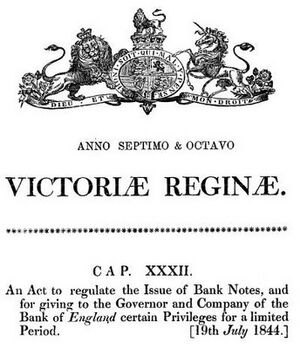Bank of England £100,000,000 note facts for kids
| (United Kingdom) | |
|---|---|
| Value | £100,000,000 sterling |
| Width | 297 mm |
| Height | 210 mm |
| Security features | Requires the signature of the existing Chief Cashier at the Bank of England |
| Obverse | |
| Design | Britannia |
| Reverse | |
| Design | Blank |
The Bank of England £100,000,000 note is a very special banknote. It is also known as Titan because of its huge value. This note is not used by people for everyday shopping. Instead, it helps support the value of money used in Scotland and Northern Ireland.
It is the largest value banknote ever printed by the Bank of England. These special notes make sure that Scottish and Northern Irish banknotes are always worth their stated value. This is important in case a local bank that prints money has problems.
Contents
What is the £100 Million Note For?
The £100,000,000 note, nicknamed "Titan," helps back up the value of regular banknotes. These are the £1, £5, £10, £20, £50, and £100 notes. These notes are printed by seven different banks in Scotland and Northern Ireland.
The million pound note also plays a similar important role. Sometimes, businesses in England and Wales are not sure about accepting Scottish or Northern Irish banknotes. This is because they might not know all the different types of notes. They also might not know how to check if they are real or fake.
Why These Notes Are Important
There is also a chance that one of the banks printing money in Scotland or Northern Ireland could close. If this happened, the banknotes they issued might become worthless. The "Titan" notes, along with the million-pound notes, help keep people confident in the value of these banknotes.
For every pound a Scottish or Northern Irish bank prints, it must deposit the same amount of money with the Bank of England. This deposit acts like a guarantee. If a bank in Scotland or Northern Ireland faced difficulties, its notes could be replaced with regular Bank of England cash. This system keeps everyone's money safe.
How the Notes Are Made and Kept Safe
The Bank of England prints these £100,000,000 notes itself. They do not use their usual printing companies. This is done for very high security reasons.
After printing, the "Titan" notes are kept in a very safe place. They are stored in the Bank of England's vault or other approved secure locations. This makes sure they are protected as valuable physical assets.
For even more security, each £100,000,000 note must be signed. The current Chief Cashier at the Bank of England signs them. Only after being signed do they become legal and can be used to back up the money from other banks.

See also
- Bank of England £1,000,000 note
- Bank of England note issues
- Gold certificate

